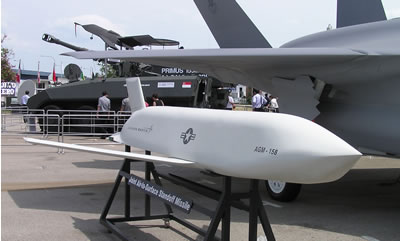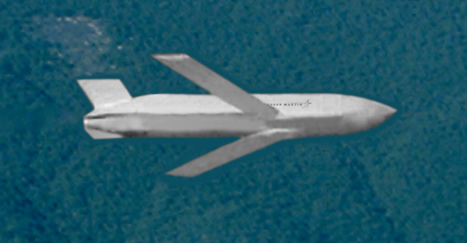The Joint Air-to Surface Standoff Missile (JASSM) is an autonomous, stealthy, long range conventional, air-to-ground, precision standoff missile used by the US Air Force and US Navy. The weapon is designed to destroy high value, well defended fixed or relocateable targets, from ranges of over 200 nm. The 14 foot long missile weighs 2,250 pound is employed as a fully autonomous “Fire and Forget” weapon. JASSM is currently deployed by B-52 and B2 bombers. Flight testing is conducted on B-1. F-16 units will get the missile by 2006. The US Navy considered the missile for its fleet of F/A-18E/F but eventuallt favored the SLAM-ER weapon. The Navy considered such weapon to augment the capabilities currently obtained only by the Tomahawk cruise missiles. Australia and South Korea have selected JASSM for their F/A-18E/F (Australia) and F-15K (South Korea).
The missile uses autonomous navigation, based on inertial and GPS navigation systems, to follow a pre-planned route which will bring it to the target area. Once in predesignated location, the missile uses its imaging infrared seeker and on-board, real-time Automatic Target Correlating (ATC) algorithms to precisely locate and guide the missile to the desired target aimpoint. Lockheed Martin’s ATC algorithms use an insensitive, redundant approach and real-time processors to provide a robust system that significantly reduces the missile’s impact circular error probability (CEP) any time of the day or night. This allows the missile to hit a precise spot, such as a specific point in a hardened bunker, cave entry or ventilation shaft, using a target model that was built months earlier. To make the missile more immune to GPS deception and jamming, JASSM Block 1A missiles are equipped with the Selective Availability Anti-spoofing Module (SAASM) technology – an enhanced, digital anti-jam Global Positioning System (GPS) receiver. This capability gives JASSM the ability to successfully complete its mission even in intense jamming environments. The entire system is prepared on the mission planning system. A typical mission can be planned in less than 30 minutes. JASSM is equipped with a 1,000 lb dual mode blast-fragmentation penetrator warhead for maximum effect against soft or hard targets. The missile is designed to fly low-level terrain following flight path, which enables effective bypassing of most enemy defenses. The advantages of its low observable properties ensure its survivability during the missile ingress to the target. The missile is also prepared to engage enemy jammers.
One of the unique features of the current model of JASSM is its capability to send back a sequence of pre-strike images of the target, just before impact. Such information provides partial battle damage assessment (BDA) capability and eliminates the need to send dedicated recce assets to verify the results of the strike.
Further improvements of JASSM ER will include an improved engine and larger fuel capacity, and an improved two-way datalink which will provide flexible re-targeting of the missile, including tracked, moving maritime targets. The ER version maintains the same outer mold lines of the stealthy airframe, which makes JASSM extremely difficult for air defense systems to engage. It also retains the dual-mode penetration and blast fragmentation warhead of the baseline JASSM missile. This capability will transform JASSM into a network-enabled system, providing in-flight re-routing, retargeting, or aimpoint refinements and blue-force tracking, to eliminate fratricide risks. The introduction of the JASSM-ER will also provide limited loitering capability or further range extension beyond 500nm. Loitering will enable planners to more flexibly integrate JASSM with other means of attacks, such as decoys, defense suppression weapons etc. Flight testing for JASSM-ER began in mid-2006 and initial fielding is expected with B-1B squadrons by 2013. The U.S. Air Force plans the total procurement of 4,900 JASSMs – both the 200 nautical-miles basic weapon and 500 nm JASSM-ERs. By late 2009 the weapon successfully completed six successful flight demonstration tests at White Sands missile testing range in New Mexico. During the latest flight test, the missile was released from a B-1B aircraft and flew a preplanned course to collect data, to fine-tune navigation algorithms, and then destroyed the designated target. The flight also confirmed the missile’s ability to be employed from the aft weapons bay of the B-1B. Flight testing will continue through mid-2010 in preparation for Operational Test and Evaluation, which will commence in 2011. A low-rate initial production decision is anticipated in 2011. The JASSM-ER missile is being integrated on the B-1B with Initial Operational Capability planned for early 2013. The JASSM-ER design is compatible with the B-2, B-52, and F-16 aircraft that currently deploy JASSM. Acquisitions are expected to last through 2018.


















